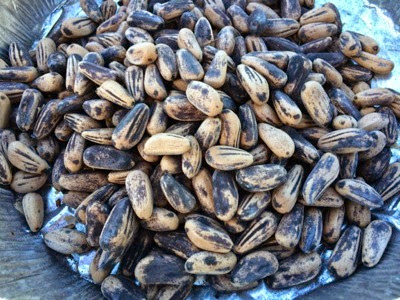
Eastside Road, July 16, 2014—
THIS IS HOW I make pesto:First I get the pine nuts. This is a laborious process. The nuts are ready right now, mid-July, and the first thing to do is to get the pine cones, from the three Italian stone pines up the hill.
Then you assemble your tools: needle-nose pliers; slipjoint pliers, a bucket, a bowl, a dish.
Then you make sure you have a couple of free hours, you arrange a comfortable place in the shade but with good light, you put on work clothes.
Then, using the needle-nose pliers, you pull the nuts out from under the scales of the pine cones. There's a pair of nuts under each scale, and they want to stay there. I usually shove the pliers in under the scale, pry up with them, then deftly or not extract the nuts, usually one at a time.
The nuts are covered with black sooty stuff, and before long your left hand is covered with pitch from the cones. Toss the emptied cone into a bucket; they're great for starting fires in the winter. Toss the sooty nuts in a bowl. Five cones gave me a couple of hundred nuts.
When you're done extracting them, rub the nuts between the palms of your hands, a few at a time, to get off as much soot as possible. The photo shows the result.
Now it's time for the slipjoint pliers. Careful: don't pinch your hand more than necessary! Carefully put a nut on edge between the jaws of the pliers and squeeze to crack the shell. The kernel is inside, wearing a brown paper jacket which it sometimes seems reluctant to give up. Don't worry about that; just toss the kernel into a little dish — you won't need a big one!. Continue cracking the pine nuts. Some will be disappointingly empty. Look out for bugs and spiders.
When you've finished cracking the nuts it's time to clean up. The cracked shells make nice barbecue fuel, along with any pine-cone scales that have scattered. Take the nuts into the kitchen. Wash the pitch off your left hand with Goo-Gone or orange oil. Change your clothes and put on an apron.

Now sort through the nuts, tossing them into the air and blowing on them to get rid of dust and such. Some of the kernels will be suspect — perhaps munched by something; perhaps dry and blasted, a little, by some kind of blight. Reject them.
On Friday, down in Berkeley, I bought two little packages of pine nuts, for $9.99 apiece. They were from Spain, and they look delicious. The cheaper pine nuts you get in various places look quite different, shorter and fatter; they come from China, and I think from a different kind of pine tree. The Italian and Spanish pine nuts are very expensive but much better.
I haven't opened those packages of Spanish nuts yet: on the right, you see the ones I picked yesterday. I toasted these nuts slightly by putting them in a hot oven after Cook had broiled salmon, leaving them in only five minutes or so.
But I've been distracted by these damn nuts. Here's how I make the pesto:
| The setup: Cheese, pine nuts, basil, garlic | 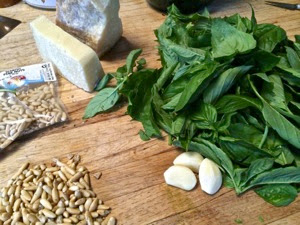 |
|---|---|
| Mash the garlic with salt. Then add the pine nuts and pound into a heavy paste. | 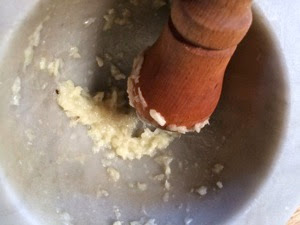 |
| Carefully slice, do not chop, the basil. Don't bruise it! | 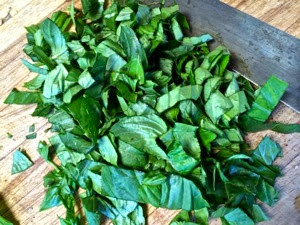 |
| Pound the sliced basil into the garlic and pine nuts. | 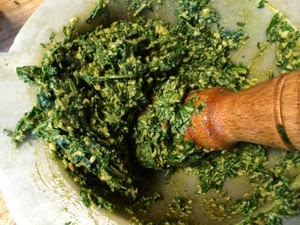 |
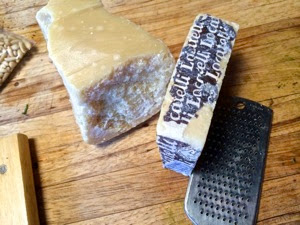 Both Parmesan and Pecorino… | 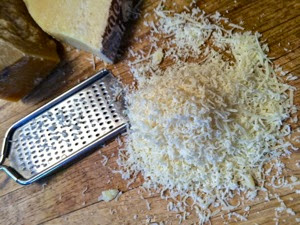 …grated (more Parmesan than Pecorino) |
| Pound in the cheese. | 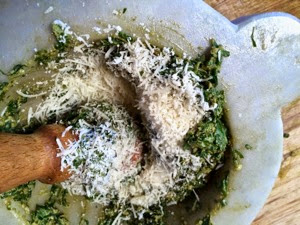 |
| When pounded to the desired texture, smooth it out with a spatula… | 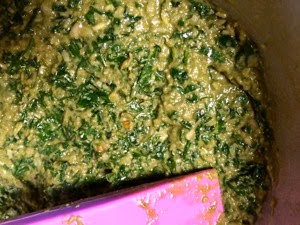 |
| …and cover it with olive oil. When ready to use, stir in the olive oil, add more if necessary, taste to see if it needs salt, and enjoy it! | 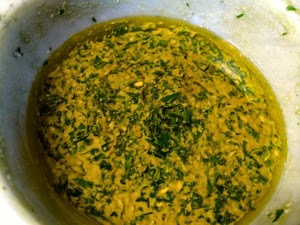 |
No comments:
Post a Comment